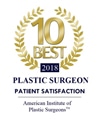The technical name for face lift surgery is “rhytidectomy.” In this surgical procedure, excess face and neck skin are removed and the tissues under the skin are tightened. Activities such as smoking, sunbathing, outdoor activities, and stress can alter the appearance of the face. Additionally, as we age deep creases may form between the nose and mouth, the jawline may grow slack and sag, and folds and fat deposits may appear around the neck. A face lift can reduce these signs of aging, resulting in a firmer, fresher appearance.
Candidates must be in good health, have no active diseases or serious, pre-existing medical conditions, and must have realistic expectations of the outcome of the surgery. Facelifts are most commonly performed on patients between 40 to 60 years old. The procedure can produce good results for people from 60 to 80 as well. If you have strong, well defined bone structure and some skin elasticity, you are most likely to have good results from a facelift.
NOTE: You may not be a candidate for surgery if you smoke, have recently quit smoking, or if you are exposed to second-hand smoke. Primary and secondary smoking decreases blood flow to the body’s tissues. This can result in prolonged wound healing, skin loss, infection, increased scarring, and a number of other complications depending on the kind of procedure performed.
The type and size of facelift depends on location and extent of skin laxity. Sizes range from “mini” to “standard”. Usually, an incision is made in the hair near the temple and continues to the front of the ear, around the ear lobe, behind the ear and into the hair. The muscles and sagging tissue are tightened and excess skin is removed. The remaining skin is repositioned to create a more youthful look. The incision is closed with sutures, or with metal clips on the scalp. A small incision may be made under the chin if a neck lift is needed.
A face lift surgery may be performed alone, or in conjunction with a brow lift, eyelid lift, or nose surgery. Your surgeon may also recommend injections of a filler or Botox to help alleviate deep creases in your forehead or frown lines between your eyebrows. To improve the texture of your facial skin, laser resurfacing or chemical peeling may be used.
First, schedule a personal consultation with your plastic surgeon. Communication is vital in reaching your goals. You will have the opportunity to discuss your goals and the results you’d like to achieve. Your surgeon will work with you to reach an understanding about what you can expect from this procedure and what long-term benefits you will experience. Every patient is different, and your surgeon will choose the surgical technique and treatment plan that is right for you.
You will be given specific instructions on how to prepare for your surgery. A pre-operative information packet will be provided that explains everything you should do and know before your surgery date. Your surgeon will instruct you on how to prepare for surgery, including guidelines on eating and drinking, smoking, and which vitamins and medications should be taken or avoided. You should arrange for someone to drive you home after your surgery, whether your surgery is done on an outpatient or inpatient basis. You may also want to make arrangements for someone to help you out for a day or two after you leave the hospital.
You’ll remain comfortable throughout the entire procedure. In most cases, general anesthetic is used so that you will sleep throughout the procedure; although local anesthesia with intravenous sedation is also an option for some patients.
It is very important that you follow your surgeon’s instructions. This will promote healing and improve progress towards your new physical appearance. Also, it is important that you attend all scheduled follow-up appointments so that your surgeon can assess your long-term results and answer any questions or concerns you may have.





I had the Laser Genesis treatment. The procedure was comfortable on my skin and without any downtime for noticeable results! I would highly recommend this procedure. The entire office is great to work with and an awesome team. L.T., Lafayette
Amazing staff , ready to answer all my questions , I felt very comfortable talking to them ,specially Leah , she made feel very secure about the procedures and totally happy of have chosen them. Zuleyma F.
Fantastic! I have had multiple procedures done by almost everyone in the office . I recommend this place to everyone! Love this place! Lindsay W.
